 Download PDF
Download PDF
Name: Thladiantha dubia Bunge
Family: Cucurbitaceae (the Gourd family)
Common Names: Goldencreeper, red hailstone, Manchu tubergourd, thladianthe douteuse (French), Thladianthe, chi bao (pinyin, China) (1,2,6,8,21).
Etymology: The genus name Thladiantha comes from Greek ‘thladias-anthos’, meaning ‘eunuch-flower’ probably referring to Bunge’s first impression that the flowers are not capable of producing fruit. The word dubia, in Latin, means ‘doubtful’ (4,9,17).
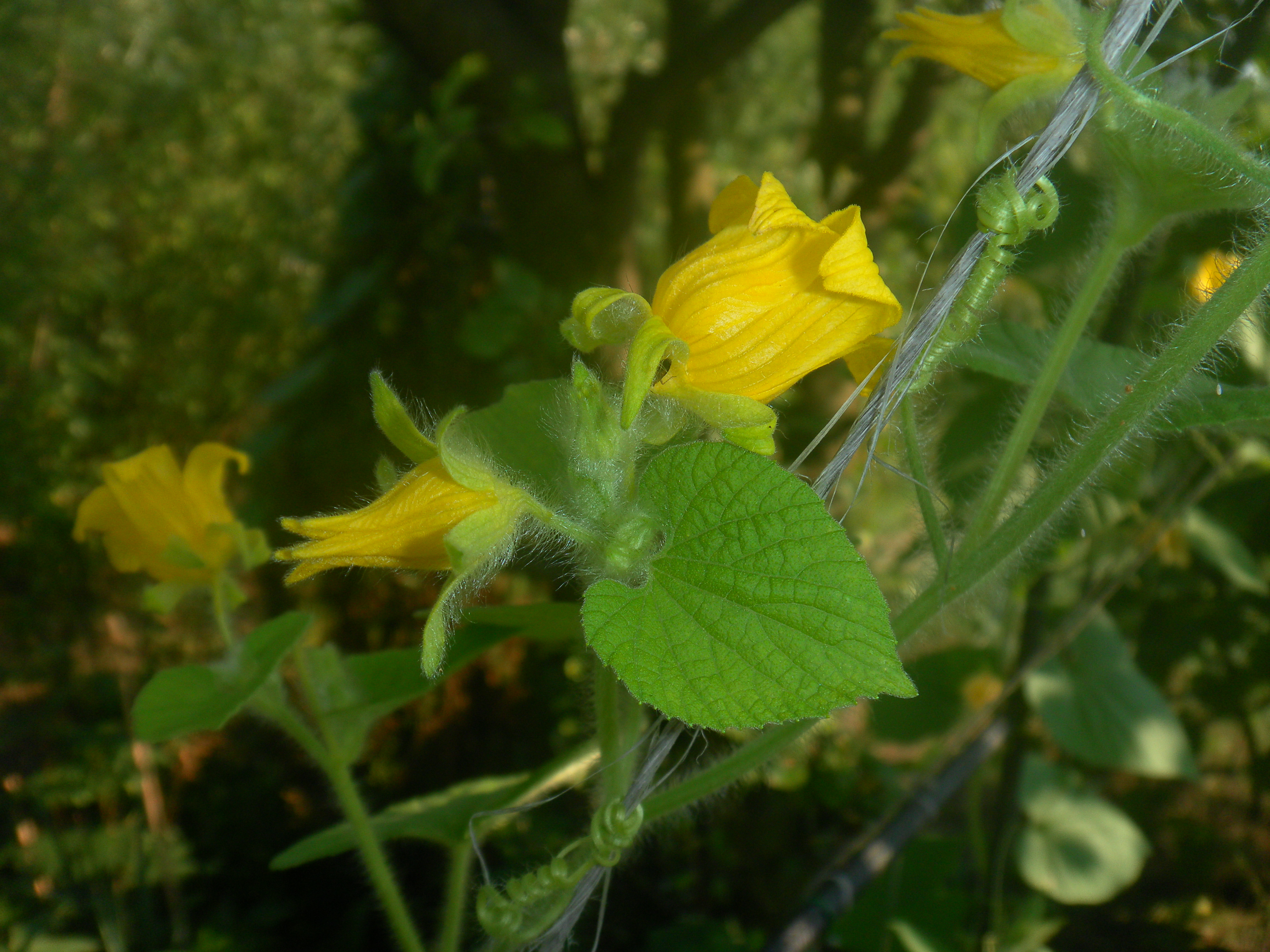
Botanical synonyms: Gymnopetalum horsfieldii Miq., G. piperifolium Miq. (5).
Quick Notable Features (1,11,12,17):
¬ Dioecious pubescent vine with alternate leaves, climbing by axillary tendrils
¬ Simple, toothed, cordate leaves, with hooked scabrous hairs
¬ Yellow, campanulate, unisexual flowers with recurved lobes
¬ Oblong red or green fruits with 10 linear grooves
Plant Height: The “goldencreeper” grows 2-6m long and up to 2m tall (7,12,15).
Subspecies/varieties recognized: none found.
Most Likely Confused with: Cucurbita ssp., Cucumis ssp., Dioscorea villosa, and Ipomoea ssp.
Habitat Preference: T. dubia grows on disturbed sites, along rivers, and on sandy shores. It is shade intolerant and prefers moist, well-drained soils (1,7).
Geographic Distribution in Michigan: The goldencreeper was only recently collected outside of cultivation in Washtenaw county (1).
Known Elevational Distribution: T. dubia grows up to 1800m above sea level in China (11).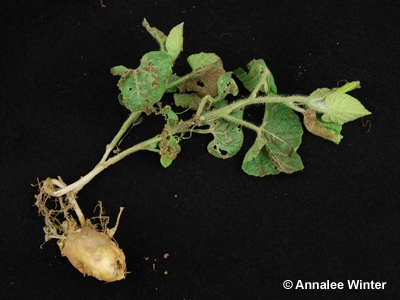
Complete Geographic Distribution: Native to East Asia (1), T. dubia was introduced to North America. In the United States it is found in IL, MA, MI, MN, NH, NY, and WI; in Canada in MB, ON, and QC (1,6,9). The goldencreeper is also found in Austria, China, Croatia, Czech Republic, France, Germany, Hungary, Italy, Japan, Lithuania, Poland, Republic of Korea, Romania, Slovakia, Slovenia, Spain, Sweeden, and Ukraine (8,13).
Vegetative Plant Description: T. dubia is a fast-growing herbaceous climber emerging from perennial tubers. The slender stems pubescent, cloaked in hooked, conical hairs. Stipules are absent, the plant bears short, scabrous, unbranched but coiled tendrils in the axils of the pubescent stout petioles. Petioles are 2-6cm long. The leaves are alternate, simple, basally cordate and apically acute, scabrous on both surfaces, irregularly serrate, 5-15cm long, and 4-9cm broad. The basal prominent sinus is up to 1.5cm deep and 3cm wide (1,11,12,18,21).
Climbing Mechanism: Goldencreeper uses its tendrils to climb over other vegetation (11,12).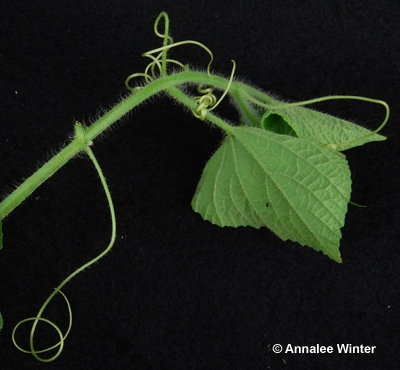
Flower Description: T. dubia is dioecious (separate male and female plants) and its axillary flowers are actinomorphic, on 1-3.5cm long pubescent pedicels. The flowers have hairs that produce oil. Both staminate and pistillate flowers have a pubescent 5-parted calyx with a 0.3-0.4cm long and 0.7-0.8cm wide tube; the lobes are reflexed, long (1.2-1.3cm) and narrow (0.2-0.3cm). The corolla is 1.5-2.5cm across, yellow, campanulate, 5-parted with reflexed lobes, and 5-7 veins per lobe. Staminate flowers are solitary or grouped, subtended by leaf-like bracts. Three stamens are present (2-2.5mm long), of which two have 2-celled anthers and one a 1-celled anther, and an undeveloped ovary. Pistillate flowers are solitary on pedicels that are shorter than in the staminate flowers (up to 1.5cm long). These bear 5 staminodes, a villous, ovoid, unilocular inferior ovary 0.5-0.8cm long, topped by a short style with 3 bifid stigmas (3,11,12,17).
Flowering Time: In Canada, the blooming period of the goldencreeper is July-September (7,21).
Pollinator: T. dubia is pollinated by insects, and is not selfing (7). Ctenoplectra bees are known visitors of Thladiantha ssp. flowers in SE Asia & Taiwan, and are believed to have co-evolved with Thladiantha (3,16). The oils produced are not attractive to European pollinators (13).
Fruit Type and Description: A green, yellowish-orange, or red fleshy, indehiscent berry is produced, with many seeds. Pubescent and ovate to oblong, the fruits have 10 linear grooves and measure 4-5cm long x 2.5-5cm wide (7,11,12,17).
Seed Description: The ovate seeds are black or gray, flat, smooth, 4-4.8mm long and 2.5-3.3mm broad (11,12,20).
Dispersal Syndrome: The goldencreeper successfully reproduces vegetatively by underground stems (tubers). The main tuber sends out underground shoots that produce new tubers every 4-8cm, creating a connected network about 50cm broad, with each tuber capable of additional shoots and becoming independent (14). Plants reported in Europe, Canada, and Michigan are mostly or all male, suggesting that vegetative reproduction is the main reproductive method, at least outside its native range (1,13,21).
Distinguished by: Cucurbita ssp. have branched tendrils, mostly palmately lobed leaves, are monoecious (separate male and female flowers on the same plant), and the yellow corolla is at least 5cm across. In contrast, T. dubia has unbranched tendrils, the leaves are not palmately lobed, the plants are dioecious, and the corolla is < 2.5cm across. Cucumis ssp. are covered in  pointed hairs only, the plants are generally monoecious, both male and female flowers can be solitary or fascicled, female flowers have 3 staminodes, and the mature fruits are glabrous. T. dubia is covered by both conical and hooked hairs, female flowers are always solitary and have 5 staminodes, and the mature fruit is pubescent. The stems of Dioscorea villosa are glabrous and occasionally winged, twinning without tendrils around adjacent vegetation, the leaves are sub-opposite and entire, flowers greenish-white, pistillate inflorescences are cymes with 4-18 tiny flowers, and the fruits are capsules. In comparison, the stems of T. dubia are pubescent and never winged, the plant climbs using its tendrils, the leaves are alternate with irregularly serrate margins, the flowers are larger and yellow, and the fruit is a fleshy berry. All Ipomoea species in Michigan are stem-twinning climbers, the flowers are perfect (functional male and female organs on the same flower), not subtended by bracts, the corolla may have yellowish in the throat only, and the fruits are capsules (1,11,17).
pointed hairs only, the plants are generally monoecious, both male and female flowers can be solitary or fascicled, female flowers have 3 staminodes, and the mature fruits are glabrous. T. dubia is covered by both conical and hooked hairs, female flowers are always solitary and have 5 staminodes, and the mature fruit is pubescent. The stems of Dioscorea villosa are glabrous and occasionally winged, twinning without tendrils around adjacent vegetation, the leaves are sub-opposite and entire, flowers greenish-white, pistillate inflorescences are cymes with 4-18 tiny flowers, and the fruits are capsules. In comparison, the stems of T. dubia are pubescent and never winged, the plant climbs using its tendrils, the leaves are alternate with irregularly serrate margins, the flowers are larger and yellow, and the fruit is a fleshy berry. All Ipomoea species in Michigan are stem-twinning climbers, the flowers are perfect (functional male and female organs on the same flower), not subtended by bracts, the corolla may have yellowish in the throat only, and the fruits are capsules (1,11,17).
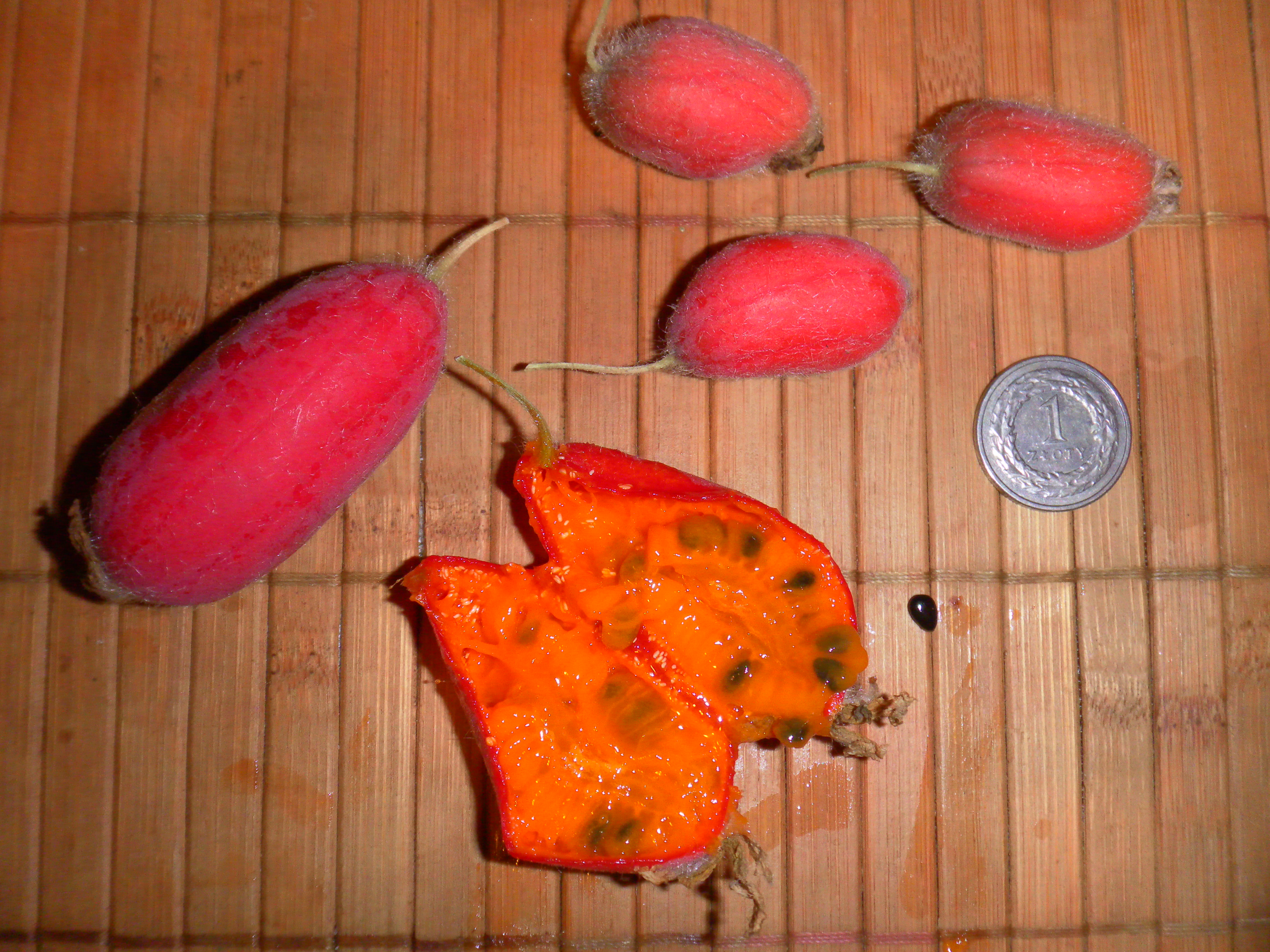
Other members of the family in Michigan (number species): Citrullus (1), Cucumis (2),Cucurbita (3), Echinocystis (1), Sicyos (1) (source 1).
Ethnobotanical Uses: The goldencreeper fruits can be consumed raw, and young shoots cooked. The seeds strengthen and stimulate the heart, and can be used as an astringent. The roots generally aid health restoration, promote the movement of bile into the intestines, can be used as a diuretic, and increase lactation (7). The fruit is used by the Manchus (in China) to relieve rheumatic, lumbar, and menstrual pain (10).
 Phylogenetic Information: The genus Thladiantha is included in the Cucurbitaceae family, which is in the Cucurbitales order, part of the Rosid I clade of Core Eudicots. Six other families are part of the order Cucurbitales: Anisophylleaceae, Corynocarpaceae, Coriariaceae, Tetramelaceae (closest to Cucurbitaceae), Datiscaceae, and Begoniaceae. Members of the Cucurbitaceae are found in tropical, subtropical, and warm temperate climates throughout the world and are very important economically. The family also includes pumpkin, squash, melon, watermelon, and cucumber (3). The genus Thladiantha has 25 species, of which 24 are native to East Asia, and 1 is native to Africa (13).
Phylogenetic Information: The genus Thladiantha is included in the Cucurbitaceae family, which is in the Cucurbitales order, part of the Rosid I clade of Core Eudicots. Six other families are part of the order Cucurbitales: Anisophylleaceae, Corynocarpaceae, Coriariaceae, Tetramelaceae (closest to Cucurbitaceae), Datiscaceae, and Begoniaceae. Members of the Cucurbitaceae are found in tropical, subtropical, and warm temperate climates throughout the world and are very important economically. The family also includes pumpkin, squash, melon, watermelon, and cucumber (3). The genus Thladiantha has 25 species, of which 24 are native to East Asia, and 1 is native to Africa (13).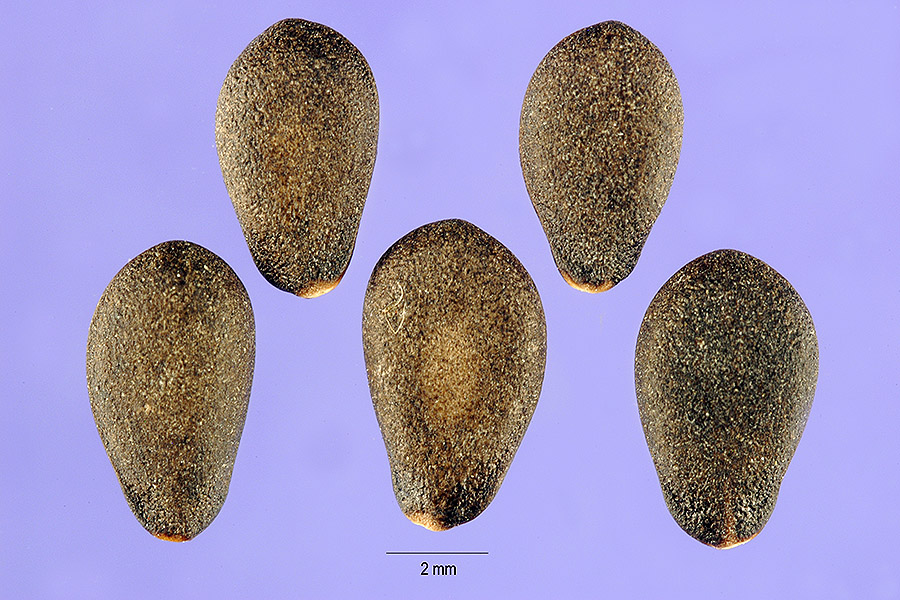
Interesting Quotation or Other Interesting Factoid not inserted above: In order to successfully produce seeds, male and female plants must be grown close to one another (7). In most countries where T. dubia naturalized, it is considered a low risk alien plant, but in Japan, it is considered an invasive (13). In China, T. dubia is considered a good plant for greening urban areas (19). “The hooked hairs make the leaves act like Velcro.” (1). The goldencreeper is very hard to eradicate due to the production of the abundant underground tubers (21).
Literature and websites used:
- Michigan Flora Online. A.A. Reznicek, E.G. Voss, & B.S. Walters. February 2011. University of Michigan. Web. May 10, 2013. http://www.michiganflora.net/species.aspx?id=2859.
- Tropicos.org. Missouri Botanical Garden. 10 May 2013 <http://www.tropicos.org/Name/9201070>
- Stevens, P.F. Angiosperm Phylogeny Website. Version 12, July 2012. http://www.mobot.org/MOBOT/research/APweb
- Mahoney, K. 2002-2013. Latdic. http://www.latin-dictionary.net/search/latin/lanatus
- Jeffrey, C. & K. Kashyapa 1960. The identity and nomenclature of Thladiantha dubia (Cucurbitaceae) of the ‘Flora of British India’. Kew Bulletin 14(3): 461-463.
- USDA, NRCS. 2013. The PLANTS Database (http://plants.usda.gov, 05/11/2013). National Plant Data Team, Greensboro, NC 27401-4901 USA.
- Plants For A Future, 1996-2012. Accessed: 11 May 2013. http://www.pfaf.org/user/Plant.aspx?LatinName=Thladiantha+dubia
- Gbif.org. Global Biodiversity Information Facility Website. Accessed: 11 May 2013.
- Robert W. Freckmann Herbarium 2013. Thladiantha dubia Bunge. University of Wisconsin, Stevens Point. http://wisplants.uwsp.edu/scripts/detail.asp?SpCode=THLDUB
- Wang, L., D. Zhao, L. Di, T. Xu, X. Lin, B. Yang, X. Zhou, X. Yang, & Y. Liu 2011. The analgesic and anti-rheumatic effects of Thladiantha dubia fruit crude polysaccharide fraction in mice and rats. J. Ethnopharmacol. 137(3): 1381-1387.
- Lu, A. & C. Jeffrey 2011. Flora of China, Vol. 19: 1. Cucurbitaceae. http://www.efloras.org/florataxon.aspx?flora_id=2&taxon_id=200022733
- AgroAtlas: Interactive Agricultural Ecological Atlas of Russia and Neighboring Countries. 2003-2009. Accessed: 11 May 2013. http://www.agroatlas.ru/en/content/related/Thladiantha_dubia/
- Alegro, A., S. Bogdanović, I. Rešetnik, & I. Boršić 2010. Thladiantha dubia Bunge (Cucurbitaceae), new alien species in Croatian flora. Natura Croatica 19(1): 281-286.
- von Marilaun, A.K. 1985. The natural history of plants: their forms, growth, reproduction, and distribution, Volume 4. London: Blackie & Son.
- Weathers, J. 1911. The Bulb Book. New York: E.P. Dutton & Co.
- Sung, I.H., A. Dubitzky, C. Eardley, & S. Iamane 2009. Descriptions and biological notes of Ctenoplectra bees from Southeast Asia and Taiwan (Hymenoptera: Apidae: Ctenoplectrini) with a new species from North Borneo. Entomological Science 12(3): 324-340.
- Fernald, M.L. 1950. Gray’s Manual of Botany, 8th ed. New York: American Book Company.
- Zomlefer, W.B. 1994. Guide to Flowering Plant Families. Chapel Hill: The University of North Carolina Press.
- Shujie, W. & Z. Jun 2007. Variety characteristics and application of woody vines to vertical greening in the cities of Northern China. Journal of Northeast Forestry University-Chinese Edition 35(12): 15.
- Bojnanský, V. & A. Fargašová 2007. Atlas of seeds and fruits of Central and East-European flora: The Carpathian Mountains region. The Netherlands: Springer.
- Ontario Ministry of Agriculture and Food 2003. Ontario Weeds: Goldencreeper. http://www.omafra.gov.on.ca/english/crops/facts/ontweeds/goldencreeper.htm
Image Credits (all used with permission):
1) Image of habit courtesy of Wojciech Maksymilian Szymanski
2) Image of tuber and shoot courtesy of Annalee Winter
3) Image of leaves and tendrils courtesy of Annalee Winter
4) Image of male flower courtesy of Wojciech Maksymilian Szymanski
5) Image of female flower courtesy of Wojciech Maksymilian Szymanski
6) Image of fruit Wojciech Maksymilian Szymanski, coin is ~ 1 inch in diameter
7) Species distribution map, derived from the Michigan Flora Online.
8) Image of seeds courtesy of Carole Ritchie @ USDA-NRCS PLANTS Database
Primary Authors: Cristine V. Santanna with revisions and editing by John Bradtke and Robyn J. Burnham.
© Robyn J. Burnham, University of Michigan
For additional information on Michigan Plant Diversity species accounts, please contact Robyn J. Burnham via email: rburnham“at”umich.edu